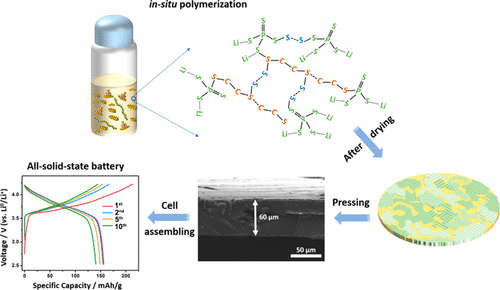当前位置:
X-MOL 学术
›
ACS Energy Lett.
›
论文详情
Our official English website, www.x-mol.net, welcomes your
feedback! (Note: you will need to create a separate account there.)
Thin Solid Electrolyte Layers Enabled by Nanoscopic Polymer Binding
ACS Energy Letters ( IF 19.3 ) Pub Date : 2020-03-04 , DOI: 10.1021/acsenergylett.0c00040 Yejing Li 1 , Xuefeng Wang 1 , Hongyao Zhou 1 , Xing Xing 1 , Abhik Banerjee 1 , John Holoubek 1 , Haodong Liu 1 , Ying Shirley Meng 1, 2 , Ping Liu 1, 2
ACS Energy Letters ( IF 19.3 ) Pub Date : 2020-03-04 , DOI: 10.1021/acsenergylett.0c00040 Yejing Li 1 , Xuefeng Wang 1 , Hongyao Zhou 1 , Xing Xing 1 , Abhik Banerjee 1 , John Holoubek 1 , Haodong Liu 1 , Ying Shirley Meng 1, 2 , Ping Liu 1, 2
Affiliation

|
To achieve high-energy all-solid-state batteries (ASSBs), solid-state electrolytes (SE) must be thin, mechanically robust, and possess the ability to form low resistance interfaces with electrode materials. Embedding an inorganic SE into an organic polymer combines the merits of high conductivity and flexibility. However, the performance of such an SE-in-polymer matrix (SEPM) is highly dependent on the microstructure and interactions between the organic and inorganic components. We report on the synthesis of a free-standing, ultrathin (60 μm) SEPM from a solution of lithium polysulfide, phosphorus sulfide, and ethylene sulfide (ES), where the polysulfide triggers the in situ polymerization of ES and the formation of Li3PS4. Reactant ratios were optimized to achieve a room-temperature conductivity of 2 × 10–5 S cm–1. Cryogenic electron microscopy confirmed a uniform nanoscopic distribution of β-Li3PS4 and PES (polyethylene sulfide). This work presents a facile route to the scalable fabrication of ASSBs with promising cycling performance and low electrolyte loading.
中文翻译:

纳米聚合物结合使固体电解质薄层成为可能
为了获得高能量的全固态电池(ASSB),固态电解质(SE)必须薄,机械坚固并且具有与电极材料形成低电阻界面的能力。将无机SE嵌入有机聚合物中具有高导电性和柔韧性的优点。但是,这种SE-in-in-polymer基质(SEPM)的性能高度依赖于有机和无机组分之间的微观结构和相互作用。我们报道了由多硫化锂,硫化磷和硫化亚乙基(ES)溶液合成的独立超薄(60μm)SEPM的情况,其中多硫化物触发了ES的原位聚合和Li 3的形成PS 4。优化了反应物比率,以实现2×10 –5 S cm –1的室温电导率。低温电镜证实β-锂的均匀纳米级分布的3 PS 4和PES(聚乙烯硫醚)。这项工作为实现具有潜力的循环性能和低电解液负荷的ASSB的可扩展制造提供了一条简便的途径。
更新日期:2020-03-04
中文翻译:

纳米聚合物结合使固体电解质薄层成为可能
为了获得高能量的全固态电池(ASSB),固态电解质(SE)必须薄,机械坚固并且具有与电极材料形成低电阻界面的能力。将无机SE嵌入有机聚合物中具有高导电性和柔韧性的优点。但是,这种SE-in-in-polymer基质(SEPM)的性能高度依赖于有机和无机组分之间的微观结构和相互作用。我们报道了由多硫化锂,硫化磷和硫化亚乙基(ES)溶液合成的独立超薄(60μm)SEPM的情况,其中多硫化物触发了ES的原位聚合和Li 3的形成PS 4。优化了反应物比率,以实现2×10 –5 S cm –1的室温电导率。低温电镜证实β-锂的均匀纳米级分布的3 PS 4和PES(聚乙烯硫醚)。这项工作为实现具有潜力的循环性能和低电解液负荷的ASSB的可扩展制造提供了一条简便的途径。











































 京公网安备 11010802027423号
京公网安备 11010802027423号